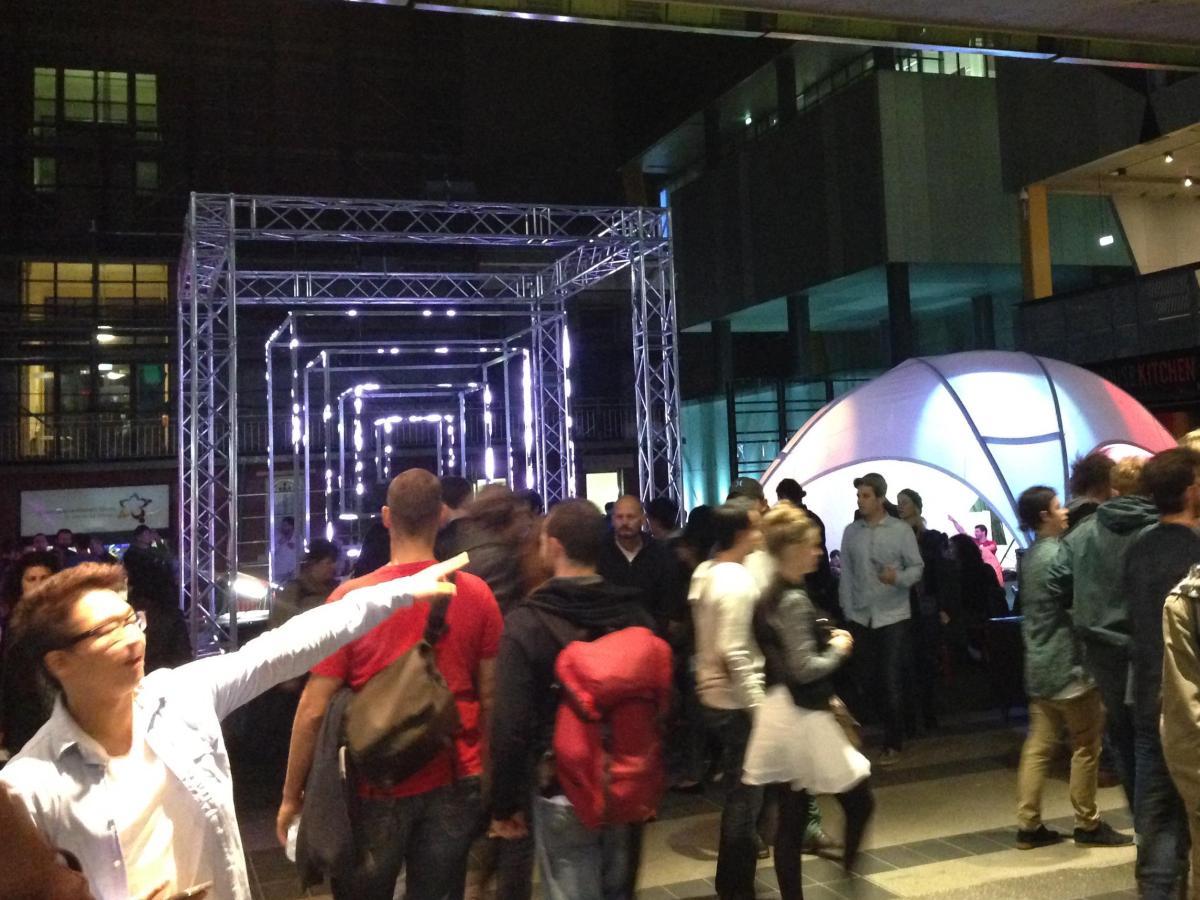Crowds at the QV Cube Photo: Esther Anatolitis
My first White Night Melbourne was a tale of two cities. Calm, curious, people dazzled by monumental projections, great bands and purple rain connecting the city’s north and south. Frustrated drivers, oblivious pedestrians and imperilled cyclists negotiating absolute gridlock across side streets east and west. Trying to be both a sited event and a distributed event, White Night created a series of punctuating experiences that fell short of making a canvas of the city as a whole.
Last year I’d been on the road, travelling home from Kalgoorlie, and so my only experience of the event was #WhiteNightMelb over a cup of tea. This year I came prepared. I booked a hotel room so that I could wander and rest, rest and wander. I spoke to artists, producers and venues ahead of the event. I used the app to program my evening. I was delighted at how straightforward it would be to plan quiet activities among the great big spectacles. And I was not disappointed.
Fresh from the Paris Nuit Blanche, Pierre Ardouvin’s Purple Rain was sheer magic: a masterful spatial transformation of subtlety on a grand scale. Light, sound, mist and the repeated form of happy-making umbrellas gave the Old Melbourne Gaol the kind of intense spatial quality that connects site with memory in a lasting way; I will always remember it thus. The Book of the Night as part of the Digital Writers’ Festival was the perfect writerly space of respite: an all-night writers’ club with an exquisite corpse unfolding for all to see. Among all the White Night stories, this one was being crafted right before our eyes. Crossing southwards, I stumbled into QV for my favourite serendipitous encounter: Kit Webster’s throbbing, pulsing cube creature that served alternately as dancefloor beacon and chillout idol.
As long as I remained on the north-south axis I was engulfed in happy crowds, patient parents pushing prams, elderly couples holding hands. As the Melbourne International Comedy Festival shows us year after year, the phenomenon of large numbers of queuing people presents its own spectacle, with human bodies making a critical mass of energy and anticipation. The sheer numbers of people walking the footpaths, midnight-picnicking in the middle of the streets, and queuing around corners and along entire city blocks, are a great strength for White Night, not a shortcoming.
I was genuinely surprised by was the repeated experience of long queues of frustrated people. At a distributed event expecting half a million people, lengthy queues are neither unexpected nor avoidable. And yet, every queue I encountered was unplanned for, and as I walked along their hundred-metre lengths, I could see the happy faces rapidly souring. The City Baths had some signs advising a one-hour wait, which was important advice given the mood.
Why not celebrate the inevitable queuing – this most familiar of community activities – and program live art or performance for it? Spending upwards of an hour moving forward at a very slow pace is a missed opportunity if all you’re doing during that hour is moving forward at a very slow pace.
A favourite experience was ducking into RMIT’s Kaleide Theatre to see Ash Keating’s Continuum. By the time I reached the space, I felt like the work’s target White Night audience: I was overstimulated, languidly tired, and ready for the sensation of long time. This is what a nocturnal rediscovery of a city is all about.
It wasn’t until I’d returned to my hotel room, passing city block after city block with no White Night reference except for all that gridlock, that it struck me what else was missing. A city-wide event needs to distribute its impacts gently, subtly. A small gesture in every shopfront in town. Something lighting every window, for example, with a simple, evocative glow. Perhaps a branding opportunity such as a White Night ricepaper lantern. One great success of the former State of Design Festival had been the passionate uptake of its satellite program, making for a very visible city for design during the annual winter festival. This encourages all participating businesses to think through the role they’re going to play in uniting Melbourne’s creative communities. And it brings the night-time city to life.
It’s the smallest of gestures that make for the most intimate spectacles. Crowd behaviour is not an accident of large-scale sited events. It’s what transforms events of scale into distributed experiences that can take the city as a blank canvas for experimentation. Closing all CBD roads to cars; dispersing well-located symbols of our shared activity; giving queuing people a focus; these are all low-fi ways to enhance a high-tech experience. A one-night sited event can become a festival if all urban elements combine to make art public, including the ways in which we inhabit our streets.




